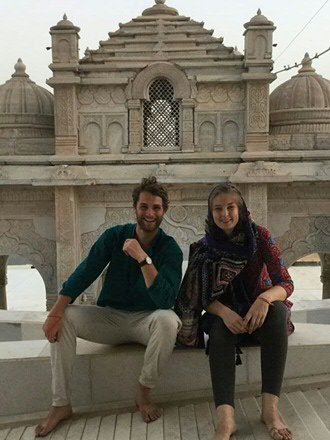India Excursion with Frankfurt’s Goethe University

Around 1 o’clock in the afternoon the plane touched down in Bhubaneswar, the first city of interest for the India excursion, organised by the Goethe University of Frankfurt and the University of Groningen in order to enlarge interest among students for research on India.
After getting used to the high temperature and humidity we continued to Utkal University to have the official excursion opening by the vice chancellor of Utkal, prof. S.M. Patnaik. Furthermore we were shown the museum of anthropology in the faculty building. The focus of the Utkal anthropology department on tribal societies caught my attention, since this is my own field of interest as well. The next day we had a tour through the old Bhubaneswar, also called the city of temples, and were able to see temple life inside the Lingaraj temple of Bhubaneswar from a platform erected by Lord Curzon during his viceroyalty. The viceroy built the platform because even he was not allowed in the sacred spaces in and around Lingaraj. Lingaraj refers to the king of the Lingam, the (an)iconic form of the deity Shiva, and is, therefore, a form of Shiva. We were very lucky we got to see the Rukuna Ratha Yatra, which was not planned but appeared to be held during our visit to Bhubaneswar. It’s a chariot festival organised to move Lingaraj from one temple to another and during which devotees are able to catch a glimpse of him.
Puri
The next day we continued to Puri, the city in which professor Hardenberg, one of the organisers, conducted research on the cult of Jagannath. Jagannath is a form of Lord Vishnu and especially significant for the north-eastern part of the country. During our 3-day stay in Puri we were divided into groups to conduct field work on a variety of topics, such as behaviour in and around the ponds of Puri, the place and use of medicine, death rituals, the activities in and around dharamsala’s, ritual bathing, and more. During our last night in Puri we got the honour to present our findings to Deepak Kumar Behera, the vice-chancellor of Sambalpur University, and witness the signing of a MoU (memorandum of understanding) between the Sambalpur and Frankfurt.
Gandhi's hometown
We continued our excursion to Ahmedabad, located in the west of India, and hometown to Mahatma Gandhi. After a lovely walk through the old city, which was recently inscribed as the World Heritage City by Unesco in 2017, we again divided ourselves into groups to have a further look on the various religious traditions existing in the city. The next stop was Palitana, home to the Shatrunjaya Hill, which is an important place for pilgrimage in Jainism since the first thirtankara of the Jain faith, Rishabha, gave his first sermon here. It is also the focus of dr. Luithle-Hardenberg’s research, one of the organizers of the excursion. We made the pilgrimage ourselves as well: a barefoot climb of 3,7 km in 35 degrees on an (almost) empty stomach. After this incredible, but tiring, experience, and in preparation of the last stop of the excursion in Mumbai, we continued to spend a day on the countryside. The final days of the excursion in Mumbai were filled with a tour through the city, visiting various religious groups, such as Sikhs, and a meeting at the university of Mumbai.
This excursion was incredible and exhausting and I am sure we could not have seen and learned more in the two weeks that were made available. My own interest in the region for future research has enormously increased and I think, regarding the initial goal of the excursion, to me it has been a great success. Many thanks to organizers and I hope, for my fellow students at the faculty of Theology and Religious Studies, that this excursion will find continuation in the coming years.
Wouter Levinga
